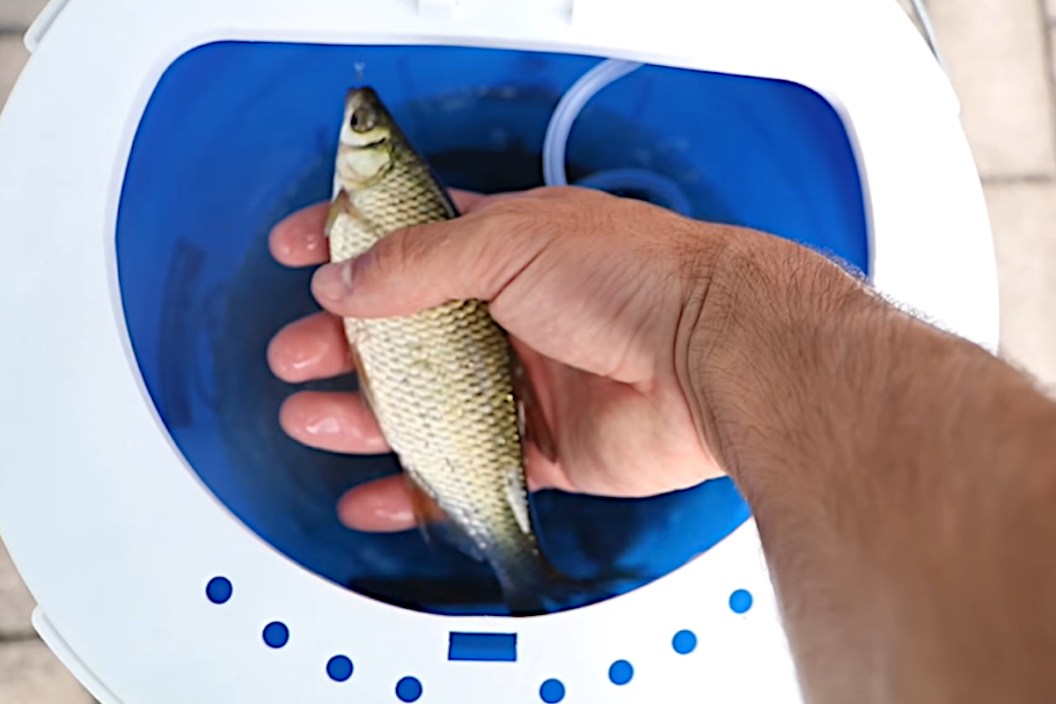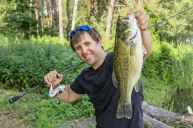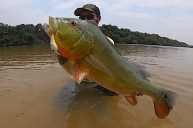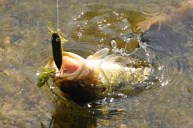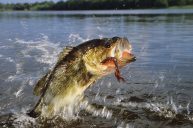When it comes to live bait, you have a lot of options!
These days some freshwater fish anglers scoff at the idea of live bait fishing. At some point we got it into our heads that to be a true angler, you must fool fish with artificial lures.
But there are some things fishing lures cannot replicate and sometimes natural bait is the best. And often, they'll out-perform your traditional soft plastics, crankbaits or spinnerbaits. Even better, the fishing tackle required to use them is simple and minimal.
Today we'll look at some traditional and not-so-traditional forms of live bait for freshwater fishing and tell you how to utilize each.
These baits are sure to make your next fishing trip a successful one.
Worms
You can't go wrong with a classic. Live worms and nightcrawlers are available at bait shops everywhere and they are fantastic for a wide variety of gamefish species.
The easiest set up you can use is to simply rig them on a hook with a split shot sinker and bobber, and go fishing. This will catch most panfish species, plenty of bass, and even some catfish if they happen to wander by. I've found big fish typically prefer the full-size nightcrawlers over the smaller worms like red wigglers.
I consider worms the best bait to go to when the angling is slow. There is just something about worms that fish can't resist. The downside is, you get a lot of small fish stealing your bait, so be sure to bring enough to cover a full day of fishing. Still, worms will help fill the livewell when all else has failed.
You can also go a bit outside the box with worms. For small and largemouth bass, a Texas-rigged live worm can trigger bites when other plastic ones fail. Worms are also fantastic for trolling for walleyes behind spinners and specialty "worm rigs." Sometimes it's the only way you can coax a bite out of these fish.
Shiners and minnows
The great thing about using a small fish as bait is that most strikes are larger fish. Both forms of baitfish are readily available for sale in most tackle shops and they work on everything from big bluegills to crappie to perch to largemouth bass, northern pike and muskie.
The way you fish these baits can vary wildly. For crappie, most anglers are going to be suspending one or even two live minnows under a bobber. You can use a similar setup for other species, but for bass fishing the setup can get even simpler.
A popular technique in Florida for shiner fishing is called free lining. All you are doing with this technique is hooking up a big shiner and allowing it to swim freely. Many anglers like to use this technique in the dog days of summer.
Hook up the shiner and let it swim under thick grass mats where the bass are hiding. All you need for this technique is a simple baitholder hook, but some anglers prefer circle hooks used more often for catfish and carp. Most prefer a strong fluorocarbon line over monofilament for this technique.
Minnows or shad can also be used to tip jigs or fished under a bobber for ice fishing for a variety of species. One of the most popular ice fishing methods is under a tip-up for big pike and muskie.
One thing to keep in mind for minnows and shiners is how you hook them. If you're suspending under a bobber or freelining a shiner, most people prefer to hook them in the back, allowing the baitfish room to move and struggle on the end of the line. That sign of distress is what will draw the big fish in.
Alternatively, you can use minnows in deep water techniques like with a drop shot rig. For a technique like that, it's best to hook them through the lips.
You'd be hard pressed to find an easier way to catch baitfish like minnows or shiners than a cast net.
One last side note on minnows and shiners: they can be more temperamental to weather while you're fishing than other forms of live bait. Especially shiners.
Make sure they don't get overheated on a hot day. A battery-operated aerator isn't a bad idea to keep oxygen flowing for them.
Leeches
These blood suckers have fallen a bit out of favor as live bait over the years, but they're great for bass, panfish and walleye.
One of the reasons leeches are so effective is because of the way they twist and squirm on a hook. This movement induces shudders in humans, but to a fish, it's like ringing the dinner bell.
You can buy leeches in tackle shops, but it's simple enough to catch your own and save some serious money. All you need is a metal coffee can or pie tin. Put in a piece of chicken or other meat and crimp the end shut. Leave enough of an opening for the leeches to get in! Attach a line and submerge it in a muddy pond or creek overnight. In the morning, it should be full.
When it comes to fishing leeches there are a variety of techniques you can use. The most common method is bobber fishing. A popular one for walleye anglers is fishing them under a slip bobber that allows you to get the leech down deep to where the fish are. You can also drop shot them.
One thing to keep in mind with leeches is that while they are quite hardy, they're also sensitive to temperature change. Most anglers keep leeches in the fridge until they are ready to fish and the temperature change between the fridge and lake often comes as quite a shock to leeches.
Introduce some water from the lake or stream you are fishing to the bait bucket when you reach your spot. You want the leeches to acclimatize and be lively when they're on the hook, because fishing with leeches that don't squirm and move on the hook is pretty much pointless.
Grasshoppers and crickets
Many expert bluegill fishermen swear by crickets as the best live bait for huge slabs, but they'll even work on bass and trout on occasion. Really, both grasshoppers and crickets are fantastic baits for a variety of species and they are easy to fish.
Usually you're just hooking them through the back and bobber fishing them with a sinker. The more they struggle, the more bites they will draw.
You can buy crickets at some bait and pet shops, but like leeches, it is also easy to capture your own with either a pitfall trap or plastic bottle trap. Both work off the same concept; all you're trying to do is lure the crickets in with rotting fruit.
For the plastic bottle trap, cut the neck off the bottle and put it in the open end. The crickets go in, but they can't find their way back out. For the pitfall trap, simply bury a container in the ground up to the opening. They come in looking for an easy meal and can't hop out.
Catching grasshoppers can be slightly more challenging. You can use a similar plastic bottle trap for them, but probably the easiest way to catch them is the simplest.
Find an old, fuzzy blanket and find a field where there are tons of grasshoppers. You'll probably want at least two other people for this. Two people hold the blanket up and then one person walks through the grass and "drives" the hoppers towards the standers holding the blanket. The hoppers get their legs tangled in the fuzzy part and can't escape, making for an easy capture. In only a few passes through the field, you should have enough to go out and catch fish.
Crayfish
Crayfish or crawfish? I guess the name depends on where you live. But in any case, there are a zillion lures out there designed to look like crayfish. So why don't more anglers use the real thing? Both large and smallmouth bass love these things!
Fishing them is incredibly simple. Thread them on a baitholder hook with your choice of weights to get them to the depth the fish are holding.
Some anglers like to hook up crawfish with an O-ring and hook setup. Personally, I think that's more trouble than it's worth, especially when the tail makes for such a great place to hook them. The tail also allows the crawfish plenty of movement, which is what will draw the fish in.
You can buy crayfish for bait at some tackle shops, but I'd caution against it for a few reasons. First, it is easy enough to catch your own crayfish. Second, there are some bait sellers out there who sell a species of crayfish called the rusty crayfish. This species' native range was originally the Ohio River Basin, but it is rapidly spreading throughout North America, much to the alarm of biologists.
The big concern is that this species displaces native crawfish in the areas it takes over. Not only that, but you could potentially get in trouble if you're caught with a rusty crayfish in an area it's not native to. In practice, it's best to just avoid those bait shop crayfish altogether.
Trust me, catching native crayfish is easy enough. You can buy commercial crayfish traps at any sporting goods store, but I've also had great luck in the past making my own. I cut the top off a two-liter soda bottle and then turned that around into the end of the bottle. Basically, I made the same funnel that's used in the cricket trap. Only this one is placed in shallow water where crayfish are abundant.
Most use an opened can of cat food for bait, but I've caught crayfish in these sorts of traps using simple white bread. It's worth it to experiment to find what works best.
Frogs
Very few predator fish can resist a live frog twitching on the end of a line, but not many anglers use these amphibians. It's probably because they are somewhat difficult to catch. But again, think about how many frog lures you saw on your last visit to the tackle shop. Many fishermen and women are missing out by not trying them!
Here's how to fish live frogs: use a baitholder hook run through the frog's lips or one of its legs. I have found in the past hooking through the leg seems to work a little bit better, if only because it affords the frog a little bit more movement.
Just like with leeches, movement is key to fishing frogs. If the bait isn't moving, the fish aren't going to take as much of an interest. And not all frogs are created equal.
Some struggle and squirm, and some just act dead on the end of the line. You can guess which one is going to be more effective.
One way to catch frogs is to use a small fly fishing fly on the end of a fishing pole. Spot the frog and dangle the fly in front of its face. The frog bites and bam, you've got your bait. Another option is to use a small net.
Or, you could simply do things the old-fashioned way: grab them. Frogs are a little like the T-Rex in the Jurassic Park movies. Their eyesight is best when something is moving. You need to move slowly when getting into position and then strike fast if you want to grab them. If you're hunting at night, you can use a light to blind them and make frogs easier to grab.
One last fishing tip regarding frogs, make sure you check your local regulations before you try to use frogs as bait. Frog numbers are decreasing in some states, and using them as bait is prohibited. In some places, there are specialty frog seasons you must adhere to. Simply put, know before you go.
For more outdoor content from Travis Smola, be sure to follow him on Twitter and check out his Geocaching and Outdoors with Travis YouTube channels.
NEXT: YOUR ULTIMATE GUIDE TO USING NIGHT CRAWLERS FOR FISHING
WATCH
